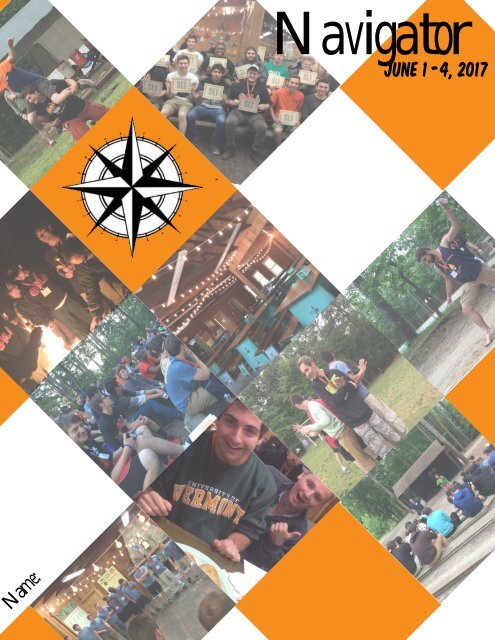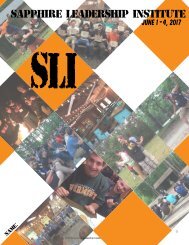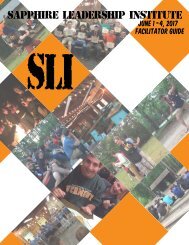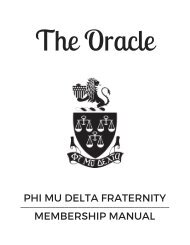NAVIGATOR 2017
Create successful ePaper yourself
Turn your PDF publications into a flip-book with our unique Google optimized e-Paper software.
Nam e:<br />
Navigator<br />
JUNE 1 -4, <strong>2017</strong>
Navigator Leadership Institute <br />
The Navigator Leadership Institute will bring together the best and brightest new members for <br />
activities designed to chart their lifetime development as a member of Phi Mu Delta. Members are <br />
nominated by their chapter/colony and are sponsored by alumni who agree to both financially <br />
support the attendee, and serve as a mentor. Members are expected to make a high level of <br />
commitment to the values of Phi Mu Delta and to serve as role models and ambassadors <br />
throughout their lifetime of membership. <br />
4:00-‐5:30 <br />
7:00-‐8:00 <br />
8:00-‐9:15 <br />
Navigator Day One -‐ Thursday <br />
3:00 Welcome <br />
Chapter Meeting One: Teambuilding <br />
5:30 Dinner <br />
Navigator Session One: Personal Leadership Practices -‐ LPI <br />
Chapter Meeting Two: Understanding of Self <br />
9:15 ChapterBuilder Training with TechniPhi <br />
Navigator Day Two -‐ Friday <br />
8:00 Breakfast <br />
9:00 – 10:15 Navigator Session 2: Exploration <br />
10:30-‐11:45 <br />
12:00 Lunch <br />
Chapter Meeting Three: Charting a Course <br />
1:00 -‐3:00 Ropes Course <br />
3:30-‐5:00 <br />
Navigator Session Three: The Fraternity Journey <br />
5:30 Dinner <br />
7:30 – 8:30 Navigator Session Four: Membership for Life -‐ Alumni Panel <br />
8:45-‐11:00 <br />
Brotherhood Session: Night Walk / Creed Talk <br />
11:00 Brotherhood Time <br />
8:00 – 9:00 Breakfast <br />
9:00-‐9:30 <br />
9:30-‐11:30 <br />
12:00 Lunch <br />
1:00-‐3:00 <br />
Navigator Day Three -‐ Saturday <br />
Brotherhood Session: Service <br />
Brotherhood Service Project <br />
Chapter of the Year Presentations & Undergraduate <br />
Representative Elections <br />
<strong>2017</strong> Navigator Leadership Institute <br />
Participant Manual <br />
Page 1
3:00-‐5:00 Navigator: Connections / Personal Action Planning <br />
5:00-‐6:00 SUPER SECRET POND TIME!! <br />
6:00-‐8:00 Awards Dinner <br />
8:00-‐10:00 Chapter Meeting Four: Imprinting Your Plan <br />
10:00 Brotherhood Time <br />
Sapphire Day 4 <br />
8:30-‐9:30 Breakfast <br />
9:30-‐10:30 Graduation <br />
11:00 Departure <br />
<strong>2017</strong> Navigator Leadership Institute <br />
Participant Manual <br />
Page 2
My Goals for Navigator <br />
1. <br />
2. <br />
3. <br />
4. <br />
5. <br />
When working with others, I am best at… <br />
When working with others, I need to improve upon… <br />
<strong>2017</strong> Navigator Leadership Institute <br />
Participant Manual <br />
Page 3
The 5 Practices of Exemplary Leadership <br />
“The theory that there are only a few select men and women who can lead <br />
others to greatness is just plain wrong.” <br />
-‐ Jim Kouzes and Barry Posner <br />
Leadership Practices Inventory Score <br />
Column 1 = Model the Way: Score ________ <br />
“Setting an example is not the main means of influencing others. It is the only <br />
means” -‐ Albert Einstein <br />
Column 2 = Inspire a Shared Vision: Score _________ <br />
“The very essence of leadership is that you have a vision. Its got to be a vision you <br />
articulate clearly and forcefully on every occasion. You can’t blow an uncertain <br />
trumpet” – Theodore Hesburgh <br />
Column 3 = Challenge the Process: Score __________ <br />
“The trouble is, if you don’t risk anything, you risk even more” – Erica Jong <br />
Column 4= Enable Others to Act: Score __________ <br />
“In organizations, real power and energy is generated through relationships. The <br />
patterns or relationships and the capacities to form them are more important than <br />
tasks, functions, roles, and positions.” – Margaret Wheatley <br />
Column 5=Encourage the Heart: Score___________ <br />
“Celebrate what you’ve accomplished, but raise the bar a little higher each time you <br />
succeed.” Mia Hamm <br />
<strong>2017</strong> Navigator Leadership Institute <br />
Participant Manual <br />
Page 4
Model the Way <br />
Modeling the way is about setting the example and creating credibility through <br />
actions that display a commitment to deeply held values and beliefs. The most <br />
frequently mentioned admired leaders throughout history and culture all had <br />
strong beliefs about matters of principle and an unwavering commitment to a <br />
clear set of values. <br />
To model the way effectively, one must have a clear and authentic <br />
understanding of their guiding principles and values. As a leader, everything you <br />
say or do tells others how you view the world. When leaders speak about their <br />
values and take action, they are speaking for their organization as well as <br />
themselves. <br />
“We must become the change we want to see” Mahatma Ghandi <br />
How do you effectively model the way inside and outside of fraternity? Where <br />
are some areas where you need to improve? <br />
<strong>2017</strong> Navigator Leadership Institute <br />
Participant Manual <br />
Page 5
Inspire a Shared Vision <br />
Exemplary leaders envision exciting and ennobling possibilities for the future of <br />
their organization. Inspiring a shared vision is about gazing across the horizons <br />
of time and imaging the exciting opportunities that are in store when the <br />
organization arrives at a distant destination. In many ways, inspiring a shared <br />
vision is about living and leading backwards. You create a clear vision of the <br />
future and allow that to pull you forward. <br />
Inspiring a shared vision is about more than creating a vision of your own, it is <br />
about enlisting others through a commitment to a future that is rooted in <br />
shared values and principles. To inspire a shared vision in others is to help <br />
others see how their hopes and dreams align with the vision and future of the <br />
organization, as people who are self motivated keep working toward a result <br />
even when there is no personal reward for them, whereas people who are <br />
externally motivated are likely to stop trying when a rewards or punishments <br />
are removed. <br />
“You don’t lead by pointing and telling people some place to go. You lead by <br />
going to that place and making a case.” Ken Kasey <br />
What is your vision? For you fraternity future? Your undergraduate career? <br />
Beyond? What help do you need to get there? <br />
Who is someone you know that you has a vision? How can you help them <br />
move forward? <br />
<strong>2017</strong> Navigator Leadership Institute <br />
Participant Manual <br />
Page 6
Challenge the Process <br />
All leaders challenge the process, and achievement is not possible by keeping <br />
things the same. Leaders who challenge the process search for opportunities to <br />
innovate, grow, and improve their organizations. They do this by seizing the <br />
imitative for themselves and encouraging initiative in others. This innovation <br />
comes from listening to the varied stakeholders and constituents of an <br />
organization. In this sense, innovation is not always about inventing the future, <br />
but also being the early adopters of new practices. Leaders who are dedicated <br />
to getting extraordinary things done are open to receiving ideas from anyone <br />
and anywhere. <br />
Challenging the process is not about challenging things for the sake of being <br />
difficult, it is about challenging the current reality in order to make things better <br />
related to the mission and values of the organization. Through this, leaders are <br />
bound to take risks and make mistakes. This is acceptable providing that <br />
mistakes and failures are opportunities to learn from rather than wasted <br />
opportunities and efforts. <br />
“Innovation distinguishes between a leader and follower” – Steve Jobs <br />
In what ways can you innovate the practices of your organization? <br />
What effect can this have on your peers and members? <br />
What “processes” do you need to challenge in your own journey? <br />
<strong>2017</strong> Navigator Leadership Institute <br />
Participant Manual <br />
Page 7
Enable Others to Act <br />
Hopes, dreams, and visions do not become a reality through the action of a <br />
single person. A team effort that is build on solid trust, strong relationships, <br />
group collaboration, and individual accountability is necessary to move an <br />
organization forward. It is impossible to get extraordinary things done in any <br />
organization without enabling others to act. Leaders do this not by hoarding <br />
power, but rather by giving it away. <br />
Enabling others to act is about building trust and fostering collaboration. <br />
Greater levels of trust within an organization lead to the greater levels of risk <br />
taking, change, and energy that is required to keep movements alive. To do this, <br />
leaders create a climate where people feel in control and are fully engaged by <br />
enabling everyone to take ownership of responsibility for the group’s success. <br />
Leaders role model this by trusting others with responsibilities and creating <br />
conditions that allow members to be successful. This instills a confidence in <br />
members that is infectious. <br />
“Confidence is going after Moby Dick in a rowboat and taking the tartar sauce <br />
with you” – Zig Ziglar <br />
What can you better do to build the confidence of your members? What <br />
effect will this have on the ability of the organization to accomplish its <br />
goals? <br />
Where are you lacking confidence and can you use the support of a <br />
team? <br />
<strong>2017</strong> Navigator Leadership Institute <br />
Participant Manual <br />
Page 8
Encourage the Heart <br />
Encouragement allows people to see the benefits of behaviors that are <br />
aligned with the important shared values of the organization. Leaders who <br />
encourage the heart recognize that caring is the heart of leadership and that in <br />
order to continue putting in long hours and persist with hard work for the <br />
betterment of the organization, people need encouragement and recognition <br />
for their efforts. <br />
This starts with setting high expectations for yourself and others and recognizing <br />
the efforts of others. Encouraging others shows that you care about the person <br />
as well as the goal and people are more willing to follow and work for leaders <br />
they trust and respect. The credibility of leaders goes up when they genuinely <br />
care and are personally involved in both the work of the organization and the <br />
celebration of the successes related to that work. <br />
“There is more hunger for love and appreciation in this world than for bread” – <br />
Mother Theresa <br />
What are some new ways that you can recognize the efforts and work of <br />
your members in order to motivate and empower? <br />
<strong>2017</strong> Navigator Leadership Institute <br />
Participant Manual <br />
Page 9
Notes, Thoughts, Ideas… <br />
<strong>2017</strong> Navigator Leadership Institute <br />
Participant Manual <br />
Page 10
Crucible: A Test or Trial <br />
• Moments of significance in our lives that impact who and what we are. <br />
• Sometimes crucibles are easily defined; sometimes hidden in memory. <br />
What are your crucibles? <br />
To identify your crucibles, reflect on the significant moments of your life this <br />
far. What impact has this crucible had? How has it shaped your values and <br />
actions? How does this influence the choices you make? <br />
Below are several empty crucible cubes. Use this cube as an example and let <br />
the questions lead your thought process during the exercise. <br />
What Makes this Event a Crucible? <br />
How does this crucible influence <br />
your actions? <br />
Crucible <br />
Place Significant Moment Here <br />
What Values does this reinforce? <br />
How does this crucible affect your <br />
goals in life? <br />
<strong>2017</strong> Navigator Leadership Institute <br />
Participant Manual <br />
Page 11
What Makes this Event a Crucible? <br />
How does this crucible influence <br />
your actions? <br />
Crucible <br />
Place Significant Moment Here <br />
What Values does this reinforce? <br />
How does this crucible affect your <br />
goals in life? <br />
What Makes this Event a Crucible? <br />
How does this crucible influence <br />
your actions? <br />
Crucible <br />
Place Significant Moment Here <br />
What Values does this reinforce? <br />
How does this crucible affect your <br />
goals in life? <br />
<strong>2017</strong> Navigator Leadership Institute <br />
Participant Manual <br />
Page 12
Reflection... <br />
• What consistencies exist among your crucible moments? <br />
• What are some potential crucibles that you may experience in <br />
the next few years? <br />
• How have yur crucibles shaped your goals in life? <br />
<strong>2017</strong> Navigator Leadership Institute <br />
Participant Manual <br />
Page 13
Notes, Thoughts, Ideas… <br />
<strong>2017</strong> Navigator Leadership Institute <br />
Participant Manual <br />
Page 14
The Shackleton Expedition <br />
Ernest Shackleton was one of the main polar explorers of the Heroic Age of Antarctic <br />
Exploration. He led three expeditions to the Antarctic, including a disastrous expedition <br />
which saw his ship get trapped in ice before being crushed and sinking. <br />
Ernest Shackleton was born in Ireland in 1874. As a child, he loved reading, and the books he <br />
read made him desperate for adventure. He was bored and restless at school and didn’t do <br />
brilliantly. He thought teachers sucked all of the fun out of literature and geography, so, when <br />
he was sixteen, he left to join the merchant navy. <br />
His family couldn’t afford for him to do a Royal Naval cadetship, so he had a choice between the <br />
mercantile marine cadet ships Worcester and Conway and an apprenticeship on a sailing vessel. <br />
He chose the apprenticeship. <br />
He spent several years learning his trade at sea, traveling and meeting people across the <br />
globe. In 1894, he passed his exam for Second Mate and became a third office on a tramp <br />
steamer. Then he passed his First Mate exam and became a Master Mariner. Finally he was able <br />
to command British ships all over the world. <br />
Shackleton eventually raised the money to fund his dream, and set out to find a crew. His <br />
advert read: <br />
“Men wanted for hazardous journey. Low wages, bitter cold, long hours of complete <br />
darkness. Safe return doubtful. Honour and recognition in event of success” <br />
<strong>2017</strong> Navigator Leadership Institute <br />
Participant Manual <br />
Page 15
When he and his hand-‐picked team set off in August of 1914 in the Endurance, Shackleton had <br />
a bold, potentially history-‐making goal: he and his team would be the first to walk across the <br />
continent, starting from the coast of the Weddell Sea, traversing the South Pole and ending up <br />
at the Ross Sea. <br />
But from the beginning, the expedition encountered unfamiliar challenges. In late 1914, the <br />
ship arrived at a whaling settlement on South Georgia Island, the last southern port of call <br />
before the Antarctic Circle. Local seamen urged Shackleton to postpone his venture because of <br />
unusually thick pack ice that could trap the ship if the wind and temperatures shifted suddenly. <br />
Impatient to get moving, Shackleton commanded the ship to continue south, navigating <br />
through the icy jigsaw puzzle. In January 1915, the vessel came within sight of the Antarctic <br />
mainland. But harsh winds and cold temperatures descended quickly, and the pack ice trapped <br />
the ship, just as the South Georgia seamen had warned. <br />
The Endurance was immobilized, held hostage to the drifting ice floes. Shackleton realized that <br />
his men would have to wait out the coming winter in the ship’s cramped quarters until <br />
summer’s thaw. <br />
Shackleton feared the potential effects of idleness, ennui and dissidence among his men more <br />
than he did the ice and cold. He required that each man maintain his ordinary duties as closely <br />
as possible. Sailors swabbed decks; scientists collected specimens from the ice; others were <br />
assigned to hunt for seals and penguins when fresh meat, a protection against scurvy, ran low. <br />
He also kept a strict routine for meals and insisted that the men socialize after dinner, as a tonic <br />
for declining morale. Still, collective disappointment, and tempers, flared. <br />
Through the routines, order and interaction, Shackleton managed the collective fear that <br />
threatened to take hold when the trip didn’t go as planned. He knew that in this environment, <br />
without traditional benchmarks and supports, his greatest enemies were high levels of anxiety <br />
and disengagement, as well as a slow-‐burning pessimism. <br />
Days became weeks, and weeks became months, and still the ice held the ship. By June 1915 — <br />
the thick of winter in the Southern Hemisphere — the ship’s timbers were weakening under the <br />
pressure created by the ice, and in October water started pouring into the Endurance. <br />
Shackleton ordered the crew to abandon the sinking ship and make camp on a nearby ice floe. <br />
The next morning, he announced a new goal: “Ship and stores have gone — so now we’ll go <br />
home.” <br />
A day later, in the privacy of his diary, he was more candid about the gauntlet in front of him. <br />
“A man must shape himself to a new mark directly the old one goes to ground,” he wrote. “I <br />
pray God, I can manage to get the whole party to civilization.” <br />
<strong>2017</strong> Navigator Leadership Institute <br />
Participant Manual <br />
Page 16
Stop at this point and disuss the following with a partner. <br />
1. Where has Shackleton failed? <br />
2. Where has Shackleton and his crew succeeded? <br />
3. What should Shackleton do next? <br />
4. How should Shackleton respond to their situation? <br />
<strong>2017</strong> Navigator Leadership Institute <br />
Participant Manual <br />
Page 17
The Shackleton Expedition – Part 2 <br />
After the Endurance sank, leaving the men stranded on the ice with three small lifeboats, <br />
several tents and supplies, Shackleton realized that he himself had to embody the new <br />
survival mission — not only in what he said and did, but also in his physical bearing and <br />
the energy he exuded. <br />
When a few men expressed skepticism about his plans, he acted quickly to contain their <br />
opposition and negativity by trying to win them over and keeping close watch on them. <br />
He assigned several potential troublemakers to his own tent on the ice, proving the value <br />
of the saying, “Keep your friends close and your enemies closer.” <br />
The men camped on the ice. They had to hope killer whales didn’t tip them into the <br />
freezing water. By April 1916, the ice began breaking up, and Shackleton ordered the men <br />
to the lifeboats, hoping to reach land along the tip of the Antarctic Peninsula. After a week <br />
of stormy seas, they arrived at the deserted Elephant Island. They were exhausted, seasick <br />
and dehydrated. But they took “childish joy,” one scientist wrote in his diary, “in looking <br />
at the black rocks and picking up the stones, for we had stepped on no land since Dec. 5, <br />
1914.” <br />
After all of that time, Elephant Island was only 100 miles from their abandoned ship. <br />
The island was barren and more than 800 miles away from the nearest inhabited land. <br />
They knew no one would find them. <br />
They were exhausted. <br />
They were cold. <br />
They were running out of food. <br />
Shackleton knew this more than anyone. He knew what he had to do. <br />
Almost immediately, Shackleton began planning his next move. Along with five other <br />
men, he managed to guide a 22-‐foot lifeboat to South George Island; from there, a <br />
smaller party reached a whaling station and help. After a meal, a bath and a change of <br />
clothes, Shackleton said, “we had ceased to be savages and had become civilized men <br />
again.” <br />
<strong>2017</strong> Navigator Leadership Institute <br />
Participant Manual <br />
Page 18
Shackleton decided to leave most of the group behind and sail to the nearest inhabited <br />
island with five men to get help. It was the last thing they wanted to do. It was winter and <br />
they were in the stormiest ocean in the world. The journey would be extremely <br />
dangerous. <br />
The waves were like mountains. The sea spray froze and their boat nearly sank with the <br />
weight of the frozen spray. They nearly sank in storms. They were constantly cold and <br />
wet. They were running out of water. <br />
Two weeks later they saw South Georgia. <br />
But they couldn’t land. A ferocious gale nearly wrecked their ship and they had to spend <br />
two more nights on the water. <br />
And even once they finally managed to land, they still had to cross to the inhabited side of <br />
the island, over land that had never been crossed before. They climbed almost 1000 <br />
meters. They couldn’t stop to rest, or they would freeze to death in the snow. They <br />
walked for twenty six hours <br />
During the next several months, he set sail in three different ships, but none could cut <br />
through the pack ice surrounding Elephant Island. Finally, on Aug. 30, 1916, aboard the <br />
Yelcho, a Chilean steamer, Shackleton sailed within sight of the island and rescued the 22 <br />
remaining men. “I have done it,” he wrote his wife, Emily. “Not a life lost, and we have <br />
been through hell.” <br />
<strong>2017</strong> Navigator Leadership Institute <br />
Participant Manual <br />
Page 19
Stop at this point and discuss the following with a new partner. <br />
1. Did Shackleton Succeed? Why or Why Not? <br />
2. What made the most difference in achieving the final outcome? <br />
<strong>2017</strong> Navigator Leadership Institute <br />
Participant Manual <br />
Page 20
The Shackleton Expedition -‐ Epilogue <br />
Shackleton led the men to safety and then went back to rescue the others. Every single <br />
man survived. Every single one. <br />
And they all believed it was because of his leadership. <br />
Shackleton kept his team together. He ignored class boundaries and made everyone <br />
equal. He kept everyone busy. He made them play football and sing songs. He was <br />
positive. He was decisive. He focused on the things he could control. <br />
Despite setback after setback, disaster after disaster, danger after danger, Shackleton <br />
never gave up. It was like the worst disaster movie with the meanest scriptwriter in <br />
existence. But Shackleton kept going and going and going, refusing to quit. <br />
Once the Endurance becme stranded, Shackleton knew that each day, his presence had <br />
huge impact on the men’s mind-‐sets. He managed his own emotional intelligence — to <br />
use a modern term — to keep his own courage and confidence high; when these flagged, <br />
he never let his men know. <br />
Just as important, Shackleton kept his men’s focus on the future. The ship was gone; <br />
previous plans were irrelevant. Now his goal was to bring the team home safely, and he <br />
improvised, adapted and used every resource at hand to achieve it. <br />
SET against a myriad of misfortune and mistakes is Shackleton’s behavior after the <br />
Endurance was trapped. Once he relinquished his first mission, to walk across Antarctica, <br />
and embraced the second, to bring all 28 men home safely, his leadership became much <br />
more effective. <br />
Shackleton assumed ultimate responsibility for his team. Perhaps he recognized that he <br />
was partly to blame for the crisis that befell the Endurance. Perhaps his naval training <br />
instilled in him a deep sense of loyalty and obligation to his fellow crew members. The <br />
men themselves understood this, and most, in turn, offered him their commitment. <br />
Shackleton devoted himself to a worthy goal. “Shackleton’s team knew that whatever <br />
came before them on the ice, their leader would give his all to bring them home alive,” <br />
she said. This knowledge, she added, “was crucial to achieving the mission, and this <br />
commitment is key today when so much is changing so fast.” <br />
Shackleton’s sense of responsibility and commitment came with a great suppleness of <br />
means. To get his men home safely, he led them across ice, sea and land with all the tools <br />
he could muster/ <br />
<strong>2017</strong> Navigator Leadership Institute <br />
Participant Manual <br />
Page 21
The Shackleton Expedition – Reflection Questions <br />
1. How does relate to our work at Navigator? <br />
2. What does Shackleton teach us about effective <br />
leadership? <br />
3. How can you apply the lessons we have learned from <br />
Shackleton to your own journey? <br />
<strong>2017</strong> Navigator Leadership Institute <br />
Participant Manual <br />
Page 22
Notes, Thoughts, Ideas… <br />
<strong>2017</strong> Navigator Leadership Institute <br />
Participant Manual <br />
Page 23
Notes, Thoughts, Ideas… <br />
<strong>2017</strong> Navigator Leadership Institute <br />
Participant Manual <br />
Page 24
Board of Directors Exercise <br />
Think of life as climbing a mountain. Your board of directors is the group of people who <br />
help you climb, influence where you climb, how you climb, how fast you climb, etc. <br />
Boards of Directors are typically made up of a chair and members. A board has general <br />
control for the direction, stability and viability of an organization. <br />
-‐<br />
-‐<br />
-‐<br />
-‐<br />
-‐<br />
We are each the chair of our own Board of Directors, representative of our life. <br />
Who is on your board? <br />
Who do you rely upon for guidance, support, or advice as your climb? <br />
Who holds a rope of influence or control in your life? <br />
Put the names of the people who currently hold a piece of the rope on your Board of <br />
Directors. List each person separately. <br />
<strong>2017</strong> Navigator Leadership Institute <br />
Participant Manual <br />
Page 25
Today’s Board of Directors <br />
Person <br />
Reason <br />
<strong>2017</strong> Navigator Leadership Institute <br />
Participant Manual <br />
Page 26
2027’s Board of Directors <br />
Person <br />
Reason <br />
<strong>2017</strong> Navigator Leadership Institute <br />
Participant Manual <br />
Page 27
2037’s Board of Directors <br />
Person <br />
Reason <br />
<strong>2017</strong> Navigator Leadership Institute <br />
Participant Manual <br />
Page 28
Board of Director’s Reflection <br />
How did your Board change over time? <br />
What remained consistent? <br />
What may be missing from your Board? <br />
How does your Board shape your Journey? <br />
<strong>2017</strong> Navigator Leadership Institute <br />
Participant Manual <br />
Page 29
Notes, Thoughts, Ideas… <br />
<strong>2017</strong> Navigator Leadership Institute <br />
Participant Manual <br />
Page 30
The Fraternity Journey <br />
What does your future look like? <br />
Topic <br />
Vision <br />
Brotherhood <br />
Service <br />
Democracy <br />
Add’l Area 1 -‐ <br />
Add’l Area 2 -‐ <br />
Add’l Area 3-‐ <br />
<strong>2017</strong> Navigator Leadership Institute <br />
Participant Manual <br />
Page 31
Notes, Thoughts, Ideas… <br />
<strong>2017</strong> Navigator Leadership Institute <br />
Participant Manual <br />
Page 32
Alumni Panel <br />
Lifelong Membership <br />
<strong>2017</strong> Navigator Leadership Institute <br />
Participant Manual <br />
Page 33
Alumni Panel <br />
Lifelong Membership <br />
<strong>2017</strong> Navigator Leadership Institute <br />
Participant Manual <br />
Page 34
Navigator Action Plan <br />
Applying fraternity lessons to my life <br />
What are the Critical Issues <br />
How will I act on these <br />
during my time as an <br />
undergraduate member? <br />
How will I teach these to <br />
others? <br />
How will I continue to act <br />
on these beyond <br />
graduation? <br />
How will I use these <br />
principles or themes to <br />
shape my future? <br />
Brotherhood <br />
Service <br />
Democracy <br />
<strong>2017</strong> Navigator Leadership Institute <br />
Participant Manual <br />
Page 35
What are the Critical Issues <br />
How will I act on these <br />
during my time as an <br />
undergraduate member? <br />
How will I teach these to <br />
others? <br />
How will I continue to act <br />
on these beyond <br />
graduation? <br />
How will I use these <br />
principles or themes to <br />
shape my future? <br />
Brotherhood <br />
Service <br />
Democracy <br />
<strong>2017</strong> Navigator Leadership Institute <br />
Participant Manual <br />
Page 36
My Commitments <br />
How Will I Commit To My Values / Themes <br />
Value / Theme <br />
Personal Commitments <br />
1. <br />
2. <br />
1. <br />
2. <br />
1. <br />
2. <br />
1. <br />
2. <br />
1. <br />
2. <br />
1. <br />
2. <br />
<strong>2017</strong> Navigator Leadership Institute <br />
Participant Manual <br />
Page 37
In One Year, I will <br />
<strong>2017</strong> Navigator Leadership Institute <br />
Participant Manual <br />
Page 38
In Three Years, I will… <br />
<strong>2017</strong> Navigator Leadership Institute <br />
Participant Manual <br />
Page 39
In 10 Years, I will… <br />
<strong>2017</strong> Navigator Leadership Institute <br />
Participant Manual <br />
Page 40
In 20 Years, I will… <br />
<strong>2017</strong> Navigator Leadership Institute <br />
Participant Manual <br />
Page 41
Finding a Mentor <br />
Choose 3 people to approach as a potential mentor. Think about those who will <br />
challenge, coach, and encourage you. <br />
Individual 1 _______________________________________________ <br />
What can this person bring? ________________________________________ <br />
________________________________________________________________________ <br />
What can I bring to the relationship? _________________________________________ <br />
________________________________________________________________________ <br />
When am I going to call them ______________________________________________ <br />
_______________________________________________________________________ <br />
Individual 2 _______________________________________________ <br />
What can this person bring? ________________________________________ <br />
________________________________________________________________________ <br />
What can I bring to the relationship? _________________________________________ <br />
________________________________________________________________________ <br />
When am I going to call them ______________________________________________ <br />
_______________________________________________________________________ <br />
Individual 3 _______________________________________________ <br />
What can this person bring? ________________________________________ <br />
________________________________________________________________________ <br />
What can I bring to the relationship? _________________________________________ <br />
________________________________________________________________________ <br />
When am I going to call them ______________________________________________ <br />
_______________________________________________________________________ <br />
<strong>2017</strong> Navigator Leadership Institute <br />
Participant Manual <br />
Page 42
THE BRIDGE BUILDER <br />
An old man, going a lone highway, <br />
Came, at the evening, cold and gray, <br />
To a chasm, vast, and deep, and wide, <br />
Through which was flowing a sullen tide. <br />
The old man crossed in the twilight dim; <br />
The sullen stream had no fears for him; <br />
But he turned, when safe on the other side, <br />
And built a bridge to span the tide. <br />
"Old man," said a fellow pilgrim, near, <br />
"You are wasting strength with building here; <br />
Your journey will end with the ending day; <br />
You never again must pass this way; <br />
You have crossed the chasm, deep and wide-‐ <br />
Why build you a bridge at the eventide?" <br />
The builder lifted his old gray head: <br />
"Good friend, in the path I have come," he said, <br />
"There followeth after me today, <br />
A youth, whose feet must pass this way. <br />
This chasm, that has been naught to me, <br />
To that fair-‐haired youth may a pitfall be. <br />
He, too, must cross in the twilight dim; <br />
Good friend, I am building the bridge for him." <br />
Miss Will Allen Droomgoole <br />
<strong>2017</strong> Navigator Leadership Institute <br />
Participant Manual <br />
Page 43
Notes, Thoughts, Ideas… <br />
<strong>2017</strong> Navigator Leadership Institute <br />
Participant Manual <br />
Page 44
Notes, Thoughts, Ideas… <br />
<strong>2017</strong> Navigator Leadership Institute <br />
Participant Manual <br />
Page 45
Notes, Thoughts, Ideas… <br />
<strong>2017</strong> Navigator Leadership Institute <br />
Participant Manual <br />
Page 46











